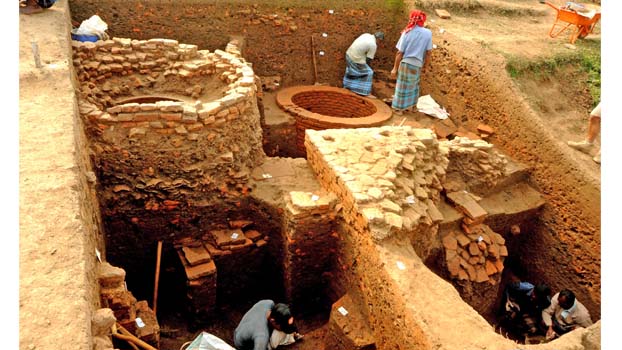Artifacts of Mourya empire discovered
Archaeologists discover eight dug-wells, earthen pots, decorated bricks at Mohasthangar


Archaeologists have discovered eight dug-wells of the Maurya empire aged 1,500 years old after excavation of a site at Mohasthangarh in Bogura.
The archeologists who are excavating the historical site of Mohasthangarh have also recovered ancient earthen pots, broken-parts of earthen pots, a large earthen water/cereal pot locally known as Dabar or Motka, burnt earthen balls, decorated bricks, used bricks and terracotta earthen pots from the site.
Five spots of Bairagir Bheeta of Mohasthangarh were excavated by the Archological team. Antiques and relics discovered from those five spots belonged to the Mourya empire, some 300 years before the Birth of Christ (BC). Some more structures and artifacts have been found during the excavation which resembled the exhibits of the Sunga and the Paul empire.
It is learnt, from 1993, Bangaladeshi and French archeologists were jointly conducting excavation of the historical sites of Mohasthangarh, situated 11 kilometre north of the district town Bogura. The ancient artifacts and relics recovered during the excavation are examples of a rich cultural human civilization and the social system of the Mourya age some 2,500-year ago. Earlier in 2017, the archeologists conducted an excavation at Boiragir Bheeta and discovered three Buddhists temples founded nearly 1,300 year ago while during the recent excavation of the same site at the southern side, eight ancient wells including a brick built well along with innumerous burnt earthen pots were discovered. Mujibur Rahman, Assistant Director of Archeology Department of Bogura informed, the wells discovered during the recent excavation were different from the wells discovered earlier. For the first time a brick built well has been discovered. Six feet of the well was dug and 46 lines of brick alignment were found while seven others were dug-wells or Pat Kua which were used for fetching drinking water from there.
He mentioned, the brick built well is presumed to be built in the 7th of in 8th century during the Paul age. The ancient relics and brick structures discovered at the site proved that the region bears an enriched cultural and historirical heritage even before the birth of Christ.
The French archeology team was headed by Collin Le Frank and members Elbo frachois and Atoan while the Bangladeshi team was headed by Regional Director of Archeology Department Dr. Nahid Sultana and team members were Mujibur Rahman, Assistant Diector, Mohammad Zayed, Custodian of Shajadpur Museum and Razia Sultana, Custodian of Mohasthan Museum.




